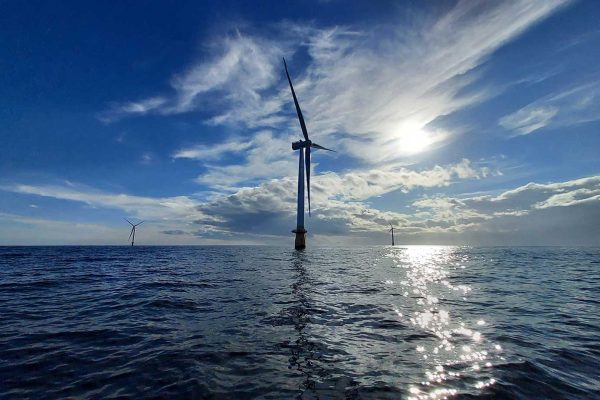The winds that whip across the ocean waters far off Maine’s coastline are a sign of hope as we seek to rapidly reduce our reliance on dirty and expensive fossil fuels and avert the worst impacts of climate change.
Placing offshore wind turbines in the Gulf of Maine using floating technology developed by researchers and students at the University of Maine, and put together at a Maine-based port, would be an enormous win-win for our economy, environment, and coastal communities.
Building reliable clean energy we need to power heat pumps, electric cars, and emerging technologies like battery storage means we need to develop Maine’s offshore wind potential. But we need to make sure we do it responsibly and in a way that benefits communities up and down the coast.
Responsibly developed offshore wind in the Gulf of Maine is moving full speed ahead, led by NRCM’s Climate & Clean Energy team and a unique coalition we’ve built with organized labor, fishing groups, and our peer environmental organizations.

Offshore wind turbine, photo by JShapiro/NRCM
Setting the Stage for Maine’s Clean Energy Future
“Maine has set the stage for a competitive new clean energy industry that will bring thousands of family-supporting jobs, protect the rich array of wildlife in the Gulf of Maine, ensure fishing communities have a voice in the process, and keep us on our trajectory to meet a goal of 100% renewable energy by 2040,” says NRCM CEO Rebeccah Sanders.
The Gulf of Maine has some of the strongest and most consistent winds in the world. Those winds peak in the winter months when our energy use is the highest. On a daily basis, offshore wind will generate the most power at night, complementing solar energy, which peaks during the day, making the two natural partners as we transition toward a clean energy economy.
NRCM’s Plan for Offshore Wind
The powerful winds that blow far off our coastline have the potential to produce enough clean, reliable energy to meet the needs of New England states for almost 40% of the year. If combined with large-capacity battery storage, this figure could jump to 70%, according to a recent report by New Hampshire’s Department of Energy.
NRCM’s plan to capture the potential for offshore wind is focused on several pillars:
Passage of the law in 2023 that directs the Maine Public Utilities Commission to procure 3 GW of offshore wind by 2040 through a competitive process, including strong standards for good-paying jobs, wildlife protection, and environmental justice.
Listening and learning from the communities that rely on the shared resources of the Gulf of Maine, especially fishing and lobstering families. Thanks to our partnership with the Maine Lobstering Union, the federal government has announced it will exclude a key fishing ground called Lobster Management Area 1 from development almost in its entirety, protecting this vital fishing resource.
Collaborating with biologists at Maine Audubon and elsewhere to ensure turbine operations minimize impacts to birds, fish, and wildlife. The law passed in 2023 will support new research to better understand how we can protect wildlife while advancing offshore wind.
Developing a Maine-based port to bring hundreds of millions of dollars in economic development from the private sector to our state, supporting the creation of thousands of good-paying jobs.
The Gulf of Maine includes about 36,000 square miles, most in federal waters. Federal and state governments will work together to identify optimal locations for commercial wind development, using the best available science and extensive input from a wide range of ocean users and stakeholders.
Maine’s offshore wind projects will likely be located 40-50 miles from the coast. Because Maine ocean waters become deep very quickly, it is not possible to build projects anchored to the sea floor, so wind turbines will be placed on anchored floating platforms far offshore.
Building a port to support constructing floating offshore wind turbines and platforms can only be done in a few places in Maine, where there’s deep water, enough space to lay down construction materials, and easy access to the Gulf of Maine, among other requirements. An Offshore Wind Ports Advisory Group and the Maine Department of Transportation Ports Authority have been evaluating the pros and cons of all possible options, weighing economic, environmental, and technical considerations.
The greatest threat to the wildlife, outdoor spaces, and coastlines we all cherish as Mainers is climate change. We have the technologies and solutions to avoid the worst impacts, but only if we act now to move rapidly away from expensive and unreliable oil and gas.
With the price of energy skyrocketing due to the volatility of the fossil fuel market, it is more important than ever that Maine develops local, reliable, and affordable clean energy sources here at home.
—by NRCM Climate & Clean Energy Director Jack Shapiro and NRCM Strategic Communications Director Colin Durrant
Article originally appeared in the Fall/Winter 2023 Maine Environment newsletter









